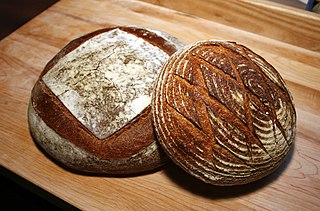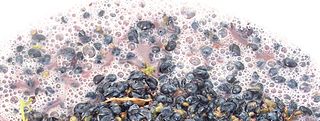
Brewing is the production of beer by steeping a starch source in water and fermenting the resulting sweet liquid with yeast. It may be done in a brewery by a commercial brewer, at home by a homebrewer, or by a variety of traditional methods such as communally by the indigenous peoples in Brazil when making cauim. Brewing has taken place since around the 6th millennium BC, and archaeological evidence suggests that emerging civilizations including ancient Egypt and Mesopotamia brewed beer. Since the nineteenth century the brewing industry has been part of most western economies.

Candidiasis is a fungal infection due to any type of Candida. When it affects the mouth, it is commonly called thrush. Signs and symptoms include white patches on the tongue or other areas of the mouth and throat. Other symptoms may include soreness and problems swallowing. When it affects the vagina, it is commonly called a yeast infection. Signs and symptoms include genital itching, burning, and sometimes a white "cottage cheese-like" discharge from the vagina. Yeast infections of the penis are less common and typically present with an itchy rash. Very rarely, yeast infections may become invasive, spreading to other parts of the body. This may result in fevers along with other symptoms depending on the parts involved.

Marmite is a British food spread produced by Unilever. Marmite is made from yeast extract, a by-product of beer brewing. Other similar products include the Australian Vegemite, the Swiss Cenovis, and the German Vitam-R.

Bread is a staple food prepared from a dough of flour and water, usually by baking. Throughout recorded history it has been a prominent food in large parts of the world and is one of the oldest man-made foods, having been of significant importance since the dawn of agriculture.

Basidiomycota is one of two large divisions that, together with the Ascomycota, constitute the subkingdom Dikarya within the kingdom Fungi.

Wheat beer is a beer, usually top-fermented, which is brewed with a large proportion of wheat relative to the amount of malted barley. The two main varieties are Weissbier and Witbier; minor types include Lambic, Berliner Weisse and Gose.

Sourdough bread is made by the fermentation of dough using naturally occurring lactobacilli and yeast. Sourdough bread has a mildly sour taste not present in most breads made with baker's yeast, and better inherent keeping qualities than other breads due to the lactic acid produced by the lactobacilli.

Baker's yeast is the common name for the strains of yeast commonly used as a leavening agent in baking bread and bakery products, where it converts the fermentable sugars present in the dough into carbon dioxide and ethanol. Baker's yeast is of the species Saccharomyces cerevisiae, which is the same species commonly used in alcoholic fermentation, which is called brewer's yeast. Baker's yeast is also a single-cell microorganism found on and around the human body.

Saccharomyces cerevisiae is a species of yeast. It has been instrumental to winemaking, baking, and brewing since ancient times. It is believed to have been originally isolated from the skin of grapes. It is one of the most intensively studied eukaryotic model organisms in molecular and cell biology, much like Escherichia coli as the model bacterium. It is the microorganism behind the most common type of fermentation. S. cerevisiae cells are round to ovoid, 5–10 μm in diameter. It reproduces by a division process known as budding.

Schizosaccharomyces pombe, also called "fission yeast", is a species of yeast used in traditional brewing and as a model organism in molecular and cell biology. It is a unicellular eukaryote, whose cells are rod-shaped. Cells typically measure 3 to 4 micrometres in diameter and 7 to 14 micrometres in length. Its genome, which is approximately 14.1 million base pairs, is estimated to contain 4,970 protein-coding genes and at least 450 non-coding RNAs.

Nutritional yeast is a deactivated yeast, often a strain of Saccharomyces cerevisiae, which is sold commercially as a food product. It is sold in the form of flakes or as a yellow powder and can be found in the bulk aisle of most natural food stores. It is popular with vegans and vegetarians and may be used as an ingredient in recipes or as a condiment.

Red yeast rice, red rice koji, red fermented rice, red kojic rice, red koji rice, anka, or ang-kak, is a bright reddish purple fermented rice, which acquires its colour from being cultivated with the mold Monascus purpureus.

Fermentation in food processing is the process of converting carbohydrates to alcohol or organic acids using microorganisms—yeasts or bacteria—under anaerobic conditions. Fermentation usually implies that the action of microorganisms is desired. The science of fermentation is known as zymology or zymurgy.

Proofing, as the term is used by bakers, is the final rise of shaped bread dough before baking. It refers to a specific rest period within the more generalized process known as fermentation. Fermentation is a step in creating yeast breads and baked goods where the yeast is allowed to leaven the dough.

The process of fermentation in winemaking turns grape juice into an alcoholic beverage. During fermentation, yeasts transform sugars present in the juice into ethanol and carbon dioxide. In winemaking, the temperature and speed of fermentation are important considerations as well as the levels of oxygen present in the must at the start of the fermentation. The risk of stuck fermentation and the development of several wine faults can also occur during this stage, which can last anywhere from 5 to 14 days for primary fermentation and potentially another 5 to 10 days for a secondary fermentation. Fermentation may be done in stainless steel tanks, which is common with many white wines like Riesling, in an open wooden vat, inside a wine barrel and inside the wine bottle itself as in the production of many sparkling wines.

Lager is a type of beer conditioned at low temperatures. The term may also be used as a verb to describe the cold-conditioning process. Lagers can be pale, amber, or dark. Pale lager is the most widely consumed and commercially available style of beer. Well-known brands include Pilsner Urquell, Molson Canadian, Miller, Stella Artois, Beck's, Brahma, Budweiser Budvar, Corona, Snow, Tsingtao, Singha, Kirin, Heineken, Carling, Foster's, Carlsberg, Birra Moretti and Tennents.

Cider is an alcoholic beverage made from the fermented juice of apples. Cider is popular in the United Kingdom and Ireland, especially in the West Country, and widely available. The UK has the world's highest per capita consumption, as well as its largest cider-producing companies. Cider is also popular in many Commonwealth countries, such as India, Canada, Australia, and New Zealand. Aside from the UK and its former colonies, cider is popular in other European countries including Portugal, France, northern Italy, and Spain. Central Europe also has its own types of cider with Rhineland-Palatinate and Hesse producing a particularly tart version known as Apfelwein. In the U.S. and parts of Canada, varieties of fermented cider are often called hard cider to distinguish alcoholic cider from non-alcoholic "cider" or "sweet cider", also made from apples.

The role of yeast in winemaking is the most important element that distinguishes wine from grape juice. In the absence of oxygen, yeast converts the sugars of wine grapes into alcohol and carbon dioxide through the process of fermentation. The more sugars in the grapes, the higher the potential alcohol level of the wine if the yeast are allowed to carry out fermentation to dryness. Sometimes winemakers will stop fermentation early in order to leave some residual sugars and sweetness in the wine such as with dessert wines. This can be achieved by dropping fermentation temperatures to the point where the yeast are inactive, sterile filtering the wine to remove the yeast or fortification with brandy or neutral spirits to kill off the yeast cells. If fermentation is unintentionally stopped, such as when the yeasts become exhausted of available nutrients and the wine has not yet reached dryness, this is considered a stuck fermentation.
Gcn4 is a transcription factor and a “master regulator” for gene expression which regulates close to one tenth of the yeast genome. In a study by Razaghi et al, amino acid starvation activated the transcription factor Gcn4p, resulting in transcriptional induction of almost all genes involved in amino acid biosynthesis, including HIS4. Thus involvement of Gcn4 in regulation of both histidinol dehydrogenase HIS4 and interferon gamma hIFNγ was hypothesised as a scenario explaining the increased level of hIFNγ under amino acid starvation.



















